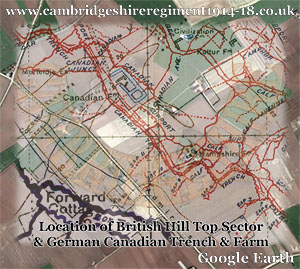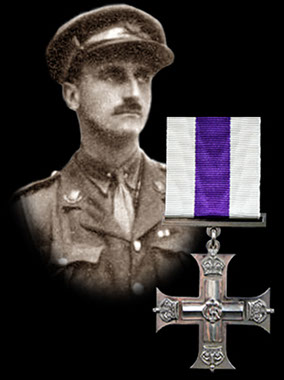
Who Were
The Cambs
The Cambs
at War
1/1st Btn 1914-1919
1914 - 1/1st Overview
1915 - 1/1st Overview
1915 - St Eloi
1915 - Fosse Wood
1916 - 1/1st Overview
1916 - The Schwaben
1916 - St Pierre Divion
1917 - 1/1st Overview
1917 - St Julien
Insignia, Medals & Books
Remembering The Cambs
Biographies
About Us &
This Site
April to May 1917 - The Canadian Trench Raid
In April 1917 the British were about launch an offensive in the vicinity of Arras, but the 39th Division, including the Cambridgeshires, were not involved, being still based in the Ypres salient where preparations were in hand for an offensive at the end of July, officially called the Third Battle of Ypres but which would become known as Passchendaele.
April and May 1917 saw the 1/1st Cambridgeshires in and out of the line around Ypres, providing numerous working parties, particularly helping load and unload material.
It was at this time that the Army decided that all soldiers in the Territorials would be renumbered, so each man serving at home or abroad was issued with a new six-figure number, which is explained elsewhere on this site (click here for further information on this).
Some reinforcements sent out from the reserve battalions in the UK were also posted to duty with labouring units before being moved on to front line infantry battalions. It is known that 40 men from 3/1st Battalion arrived in December and were posted to No 2 Entrenching Btn and used as labourers until May 1917 when they were posted, not to 1/1st Cambs, but to 8th Lincolnshire Regiment. These men included a group hit by shellfire on April 2, resulting in one man (Pte J H Nixey) being killed and six men being wounded and sent via the 4th Canadian Field Ambulance back to the UK on April 9.
From April 9 the 1/1st Cambs was providing 500 men each day to work on the railway between Peselhoek to Wieltje until April 24, while others underwent training.
Several of the Cambs men were attached to the 118th Brigade’s Trench Mortar Battery, where on April 14 there was an accident during a bomb throwing practice. It resulted in the deaths of 2nd Lt Stanley Ernest Boulting, from London, who had joined the 28th Londons (Artists Rifles) early in the war and had been commissioned into the Suffolk Regiment in September 1916, before being attached to the 1/1st Cambs and transferred to the 118th TMB.
With him was Cpl William James Rolph, from Bottisham. Rolph had distinguished himself during the German attack at St Eloi on March 14/15, 1915 when he saved a wounded comrade, Pte George Salmon. For this he was Mentioned in Despatches, later being upgraded to a retrospective Military Medal in 1916. Rolph and Boulting are buried in Houtkerque Churchyard, France.
On April 28, the 1/1st Battalion returned to the Canal Bank area, as left support to 118th Brigade in Hilltop sector where the British were making regular raids to discover information about German dispositions and capture prisoners. On May 2 the Cambridgeshires replaced the 1/1st Herts in Hilltop sector, where during several nights they sent out patrols to investigate some saps out of the German line. During the night of May 9, men heard German wiring parties at work, so the following night a party of 30 under Lt Edmund James Robert Kemplen went out and concealed themselves in a ditch in the hope of capturing the wiring party, but the Germans did not appear. On May 10, the Battalion was relieved and moved into support along the Canal Bank.
Once again they were again sending parties or fatigue work on the Canal Bank and in the line, while in the front line the Royal Engineers had blown up some dugouts near Canadian Trench and following night the British artillery bombarded the area. The British were about to send out another raid, for which on May 12 the Cambridgshires received their orders.
Their task was to raid the German-held Canadian Trench in front of St Julien – the raiding party would be four officers and 70 other ranks of D Coy. Commanding the raid was Capt Charles Luker Awbery, a chartered accountant from Epping. He had gone to war with the 4th Essex and served at Gallipoli. After a period of sick leave he was posted to the Cambridgeshire Regiment in France and had been awarded the Military Cross for bravery at St Pierre Divion. He would be killed on July 31, 1917, close to the site of the trench raid in front of St Julien. The other officers on the raid were Lt Kemplen, Lt Harry Walter Baynes Smith and 2nd Lt Henry Vincent Raven.
On May 14 the British artillery bombarded Saps 11, 13 and 14, and in retaliation the Germans shelled the British line, which may have signified they expected a raid or would make their own at some stage.
During the night of May 14/15, the raiders went in. At zero hours the British opened a hurricane barrage on the German barbed wire. Five minutes later the guns lifted on to the German front line and a minute later on the support line and eventually formed a box barrage around the raiders. Two dummy barrages were put down in the hope of deceiving the Germans into the British objective.
The Germans sent up very lights from their reserve line, but not their front line (which it turned out was lightly held) and, as expected, their artillery bombarded the British lines; the Germans appeared to be deceived about the destination of the British raiders. The raiders, in two columns, entered the German line at 11.52pm with a view to identifying the German defenders. They captured two prisoners, at cost of two wounded (2nd Lt Raven and Pte Frank Clampin). A platoon of C Coy took over the front line from where raid departed, resulting in one man of this support platoon, Pte Charles Edward Bensley, of Wisbech, being killed. The battalion was relieved on May 15 and returned to Ypres, once again providing large working parties to work on the new railways. Later in the month, it was reported that L/Cpl Sid Gill and Pte Ernest Buck had both been awarded the Military Medal and Lt Kemplen the Military Cross for their parts in the raid.
Gill, from March, would be killed in September 1917. Buck, from Chesterton, would be gassed in early July and sent back to England, later being transferred to the 11th (Cambs) Suffolk Regiment.
Those men working on the railway were also subjected to German shellfire causing casualties, most of whom are buried in Vlamertinghe Military Cemetery. The final few days of the month saw the death of another officer, Capt Arthur Sutcliffe Armstrong, from Essex. He had enlisted in 1914 as a private in the Honourable Artillery Company and was commissioned later that year into the Bedfordshire Regiment. Posted to 1/1st Cambs , he was attached to brigade headquarters as bombing officer. He was wounded accidentally by the explosion of a grenade on May 27 and died of his wounds on May 31.

This site went live on the 14th February 2015 to mark 100 years since the 1/1st Cambs went off to war.
WE WILL REMEMBER THEM
Email us: cambsregt@gmail.com
Copyright 2015, 2016, 2017, 2018, 2019 by Felix Jackson. The information and images on this site should not be reproduced without prior permission.


